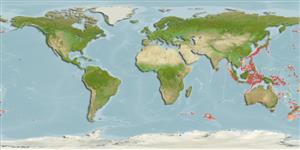>
Anguilliformes (Eels and morays) >
Muraenesocidae (Pike congers)
Etymology: Gavialiceps: Hindi, ghariyal = gavial, saurian of Ganges, 1825 + Greek, kephale = head (Ref. 45335); javanicus: Named after its type locality (Ref. 44791).
Environment: milieu / climate zone / depth range / distribution range
Ecologia
marino batidemersale; distribuzione batimetrica 560 - 600 m (Ref. 44791). Deep-water
Distribuzione
Stati | Aree FAO | Ecosystems | Presenze | Point map | Introduzioni | Faunafri
Indo-West Pacific: Java, Indonesia and northwestern Australia.
Size / Peso / Age
Maturity: Lm ? range ? - ? cm
Max length : 89.0 cm TL maschio/sesso non determinato; (Ref. 44791)
Short description
Morfologia | Morfometria
Dark brown, the back is darker than the belly. Peritoneum, gill and mouth cavities are dark and show through the skin. Stomach is bright, does not reach above the anus, its length is 2.1 times the length of the head (Ref. 44791).
Life cycle and mating behavior
Maturità | Riproduzione | Deposizione | Uova | Fecundity | Larve
Karmovskaya, E.S., 1994. Systematics and distribution of the eel genus Gavialiceps (Congridae) in the Indo-West Pacific. J. Ichthyol. 34(3):73-89. (Ref. 44791)
IUCN Red List Status (Ref. 130435)
Threat to humans
Harmless
Human uses
Informazioni ulteriori
Nomi ComuniSinonimiMetabolismoPredatoriEcotossicologiaRiproduzioneMaturitàDeposizioneSpawning aggregationFecundityUovaEgg development
Age/SizeAccrescimentoLength-weightLength-lengthLength-frequenciesMorfometriaMorfologiaLarveDinamica popolazioni larvaliReclutamentoAbbondanzaBRUVS
BibliografiaAcquacolturaProfilo di acquacolturaVarietàGeneticaElectrophoresesEreditarietàMalattieElaborazioneNutrientsMass conversion
CollaboratoriImmaginiStamps, Coins Misc.SuoniCiguateraVelocitàModalità di nuotoArea branchialeOtolithsCervelliVista
Strumenti
Special reports
Download XML
Fonti Internet
Estimates based on models
Preferred temperature (Ref.
123201): 2 - 8.8, mean 7.6 °C (based on 26 cells).
Phylogenetic diversity index (Ref.
82804): PD
50 = 0.5313 [Uniqueness, from 0.5 = low to 2.0 = high].
Bayesian length-weight: a=0.00132 (0.00056 - 0.00309), b=2.93 (2.73 - 3.13), in cm total length, based on LWR estimates for this (Sub)family-body shape (Ref.
93245).
Trophic level (Ref.
69278): 3.9 ±0.6 se; based on size and trophs of closest relatives
Resilienza (Ref.
120179): Medio, tempo minimo di raddoppiamento della popolazione 1.4 - 4.4 anni (Preliminary K or Fecundity.).
Fishing Vulnerability (Ref.
59153): High vulnerability (56 of 100).
